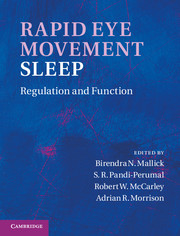Book contents
- Frontmatter
- Contents
- Contributors
- Preface
- Acknowledgments
- Organization
- Section I Historical context
- Section II General biology
- 6 The ontogeny and function(s) of REM sleep
- 7 Evolutionary perspectives on the function of REM sleep
- 8 A systems-level approach to human REM sleep
- 9 REM-sleep regulation: circadian, homeostatic, and non-REM sleep-dependent determinants
- Section III Neuronal regulation
- Section IV Neuroanatomy and neurochemistry
- Section V Functional significance
- Section VI Disturbance in the REM sleep-generating mechanism
- Index
- Plate section
- References
8 - A systems-level approach to human REM sleep
from Section II - General biology
Published online by Cambridge University Press: 07 September 2011
- Frontmatter
- Contents
- Contributors
- Preface
- Acknowledgments
- Organization
- Section I Historical context
- Section II General biology
- 6 The ontogeny and function(s) of REM sleep
- 7 Evolutionary perspectives on the function of REM sleep
- 8 A systems-level approach to human REM sleep
- 9 REM-sleep regulation: circadian, homeostatic, and non-REM sleep-dependent determinants
- Section III Neuronal regulation
- Section IV Neuroanatomy and neurochemistry
- Section V Functional significance
- Section VI Disturbance in the REM sleep-generating mechanism
- Index
- Plate section
- References
Summary
Summary
The organization of regional brain function during human rapid eye movement sleep (REMS) can be characterized at the macroscopic systems level by functional neuroimaging techniques. Several aspects of REMS have been investigated. During REMS, forebrain activation pattern is characterized by a hyperactivity in posterior cortical areas and regions of the limbic and paralimbic system, contrasting with a relative quiescence of the polymodal associative cortices of the lateral frontal and parietal cortices. This activity pattern has been related to the main characteristic of dreams. The activity associated with rapid eye movements has been identified in the thalamus and primary visual cortex, suggesting the existence of ponto-geniculo-occipital (PGO) waves in humans. The variability of heart rate during REMS is associated with the activity in the extended amygdala, suggesting a specific organization of autonomic regulation during REMS. The distribution of regional brain activity during REMS was shown to depend on experience acquired during previous wakefulness. Training on a serial reaction time task induces an increase in activity in the brain stem, thalamus, occipital, and premotor areas during subsequent REMS. These data suggest that REMS is implicated in offline memory processing. With the advent of multimodal functional imaging (electroencephalography/functional magnetic resonance imaging (EEG/fMRI), transcranial magnetic stimulation/ electroencephalography (TMS/EEG), and multichannel electroencephalography (MEEG)), a finer grain characterization of human REMS will lead to a better understanding of this intriguing state of vigilance.
- Type
- Chapter
- Information
- Rapid Eye Movement SleepRegulation and Function, pp. 71 - 79Publisher: Cambridge University PressPrint publication year: 2011
References
- 4
- Cited by



